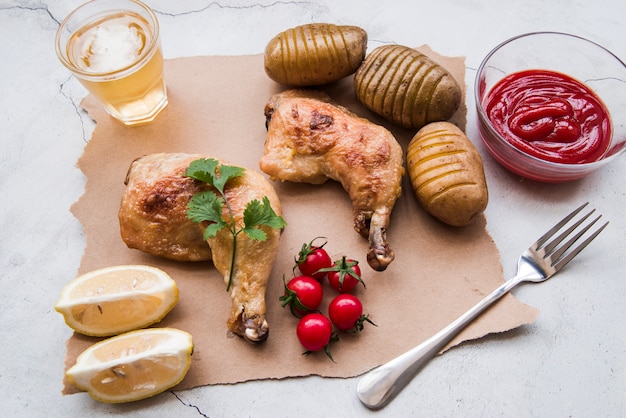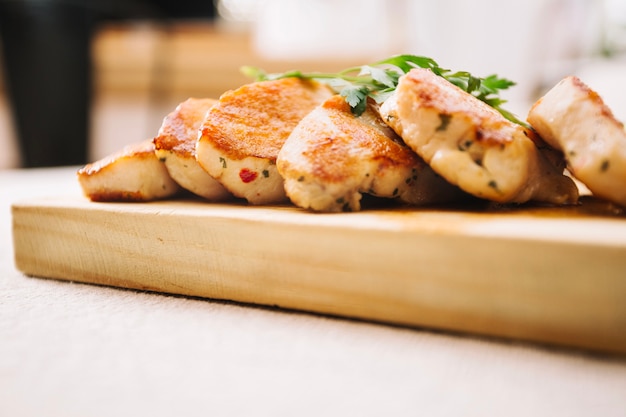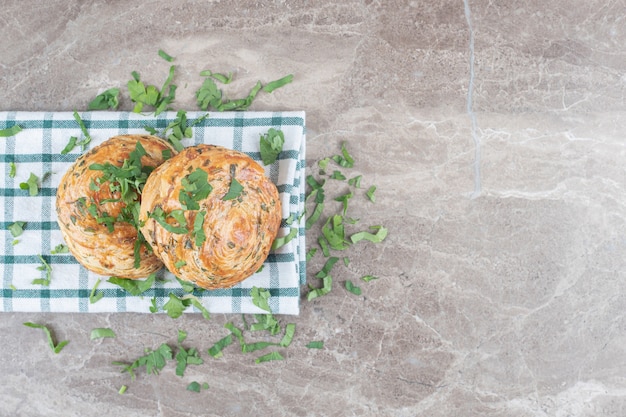Alright, let's talk about stuffed chicken breasts. They're a staple in my kitchen for a reason: they're versatile, flavorful, and can be dressed up or down for any occasion. But getting the cooking time right can be a bit of a puzzle, can't it? You don't want dry, overcooked chicken, do you? And nobody wants a soggy, undercooked center! So, here's my ultimate guide to achieving perfect stuffed chicken breasts, every time. I'll share all my tips and tricks, the ones I've learned over years of trial and error!
(Part 1) The Basics

Why Stuffed Chicken Breasts are a Whole Different Game
You see, stuffing a chicken breast changes the game a bit. It's not just about roasting a plain piece of meat. You've got to factor in the filling – whether it's a simple breadcrumb mixture or something more elaborate – and how it affects the cooking process. The filling adds moisture, which is great, but it also means you need to adjust your cooking time accordingly.
Imagine, for example, the difference between a simple breadcrumb mixture and a filling packed with cheese and vegetables. The latter will take longer to cook through because of the moisture content.
Doneness: The Golden Rule
We all know that chicken needs to be cooked thoroughly to kill off any bacteria. But when it comes to stuffed chicken breasts, remember the filling too! You want to ensure that the entire thing is piping hot, right through to the center. That's where the right cooking time comes in.
Beyond the Basics: The Importance of Texture
Beyond safety, there's also the texture of the chicken and the filling to consider. You want the chicken to be tender and juicy, and the filling to have the perfect consistency – not too dry or soggy. To get it right, you need to understand how different factors impact cooking time.
(Part 2) Decoding Cooking Times

Size Matters, My Friend
The size of your chicken breasts will significantly impact the cooking time. Smaller breasts will cook faster than larger ones, it's just common sense, really. For even cooking, aim for breasts that are roughly the same size. You can always cut larger breasts in half to achieve this.
Filling: The Secret Ingredient
Your chosen filling will also influence the cooking time. A moist filling, like one with lots of cheese or vegetables, will take longer to cook through than a drier filling. Remember that breadcrumb-based fillings will need less time than those containing moist ingredients.
Cooking Methods: A World of Possibilities
Whether you're roasting, baking, or pan-frying your stuffed chicken breasts, the cooking method will make a difference. For instance, roasting in the oven will generally take longer than pan-frying. This is because oven heat is more indirect and takes time to penetrate the meat.
(Part 3) roasting stuffed chicken breast: The Classics Never Fail

Roast chicken breast cooking times – The Breakdown
Here's a table to give you a rough guide to cooking times for roast stuffed chicken breasts. Keep in mind that these are just estimates, and it's always best to use a meat thermometer to ensure doneness.
| chicken breast size | Filling Type | Cooking Time |
|---|---|---|
| Small (5oz) | Dry (breadcrumb, nuts) | 25-30 minutes |
| Small (5oz) | Moist (cheese, vegetables) | 30-35 minutes |
| Large (8oz) | Dry (breadcrumb, nuts) | 30-35 minutes |
| Large (8oz) | Moist (cheese, vegetables) | 35-40 minutes |
Pro Tips for Roasting Perfection
Pre-heat your oven: Always preheat your oven to 350°F (175°C) for even cooking. This ensures the heat penetrates the chicken breast evenly from the start.
Don't overcrowd the pan: Give your chicken breasts some space in the baking dish. Overcrowding can lead to uneven cooking, with some breasts getting overcooked while others remain underdone.
Cover for moisture: If your filling is on the drier side, cover the chicken breasts with foil for the first half of the cooking time. This helps to prevent drying out and ensures the chicken stays juicy.
Rest before serving: Let your roasted chicken breasts rest for about 10 minutes before carving. This allows the juices to redistribute throughout the meat, resulting in a more tender and flavorful chicken.
(Part 4) pan-frying stuffed chicken breast: Quick & Delicious
Pan-Frying Time Guide
| Chicken Breast Size | Filling Type | Cooking Time |
|---|---|---|
| Small (5oz) | Dry (breadcrumb, nuts) | 10-12 minutes |
| Small (5oz) | Moist (cheese, vegetables) | 12-15 minutes |
| Large (8oz) | Dry (breadcrumb, nuts) | 15-18 minutes |
| Large (8oz) | Moist (cheese, vegetables) | 18-20 minutes |
Pan-Frying Tips: A Masterclass in Flavor
Heat your pan: Use a heavy-bottomed pan, like cast iron, and heat it over medium-high heat. This ensures the chicken browns beautifully and develops a crispy crust.
Oil is your friend: Add a good amount of oil to your pan. This will help prevent sticking, ensure even browning, and add a touch of richness to the flavor.
Don't overcrowd the pan: Like with roasting, give your chicken breasts enough space to cook properly. If you cram too many breasts into the pan, they'll steam instead of fry, resulting in a less appealing texture.
Flip it: Flip your chicken breasts once they're browned on one side. Be careful not to break the filling. You want to create a nice sear on both sides while keeping the filling intact.
(Part 5) The Ultimate doneness test: Using a Meat Thermometer
The Best Way to Tell if It's Ready
The best way to make sure your stuffed chicken breasts are cooked through is to use a meat thermometer. This is the most accurate and reliable method. You want to aim for an internal temperature of 165°F (74°C).
Using a Meat Thermometer: A Step-by-Step Guide
Insert the thermometer: Insert the thermometer into the thickest part of the chicken breast, making sure it doesn't touch any bone.
Read the temperature: Wait for the thermometer to give you a reading. You'll want to ensure it reaches 165°F (74°C).
Remove from heat: Once the chicken reaches 165°F (74°C), remove it from the oven or pan.
(Part 6) Making Sure the Filling is Cooked Through: It's All About the Inside
The Importance of the Filling
It's not just about the chicken being cooked through, remember? You need to make sure the filling is fully cooked too. That's where the real magic happens!
How to Check the Filling
Cut a small slit: Carefully cut a small slit into the side of a chicken breast. You'll get a peek into the deliciousness.
Look and feel: Check the filling inside. It should be cooked through and not pink or raw. It should also feel firm to the touch, indicating it's fully cooked.
Temperature check: If you're unsure, use your meat thermometer to check the temperature of the filling. It should reach at least 165°F (74°C).
(Part 7) Preventing Dry Chicken: The Secrets to Juicy Perfection
The Secrets to tender chicken: A Symphony of Flavors
We all hate dry chicken, right? Here are a few tips to prevent your stuffed chicken breasts from turning into a rubbery mess:
Moist Filling: Choose a moist filling that will keep the chicken juicy. Think of ingredients like cheese, vegetables, and sauces that will release moisture during cooking.
Don't overcook: Cook your chicken breasts just until they reach the correct internal temperature. Overcooking will dry out the chicken and make it tough.
Rest before carving: Let your chicken breasts rest for 10 minutes before slicing. This allows the juices to redistribute, resulting in a more tender and flavorful chicken.
(Part 8) Cooking Stuffed Chicken Breast on the BBQ: A Summertime Treat
BBQ Time!
Grilled stuffed chicken breasts are absolutely delicious, especially during the summer months. But they can be a bit trickier to cook than oven-roasted or pan-fried versions.
BBQ cooking tips: The Perfect Grill Marks
Prepare a medium-high heat: Make sure your grill is heated to medium-high heat before you start grilling. This ensures a nice sear on the chicken.
Use a grill pan: For more even cooking, use a grill pan. This will create those perfect grill marks without the worry of the chicken falling through the grates.
Close the lid: Close the lid on your grill to create a nice even heat and help the chicken cook through. The lid traps heat, promoting even cooking.
Flip it: Flip your chicken breasts halfway through the cooking time to ensure they're cooked evenly.
(Part 9) Serving Your Delicious Stuffed Chicken Breast: A Feast for the Senses
Serving Suggestions: Unleashing flavor combinations
Once your stuffed chicken breasts are cooked to perfection, you've got a blank canvas for endless flavor combinations. Here are a few ideas to inspire your culinary creativity:
Classic sides: A simple salad, roasted vegetables, or mashed potatoes are always a good choice. These provide a classic accompaniment to the chicken.
Rice and grains: Pair your chicken breasts with rice, quinoa, couscous, or bulgur wheat. These add a hearty and satisfying element to the meal.
Sauce it up: Add a delicious sauce, like a creamy mushroom sauce or a tangy lemon sauce. Sauces can elevate the flavor profile and add a touch of elegance.
Make it a meal: Serve your stuffed chicken breasts with a side of roasted potatoes or sweet potato fries. This creates a complete and satisfying meal.
(Part 10) FAQs: Your Stuffed Chicken Questions Answered
1. Can I freeze stuffed chicken breasts?
Yes, you can definitely freeze stuffed chicken breasts. Simply wrap them tightly in cling film and store them in the freezer for up to 3 months. To cook frozen stuffed chicken breasts, defrost them overnight in the fridge and then cook them as usual.
2. Can I make stuffed chicken breasts ahead of time?
Absolutely! You can prepare your stuffed chicken breasts in advance and then refrigerate them until you're ready to cook them. However, don't overstuff them, as this can make them difficult to cook through.
3. How do I know if the filling is cooked through?
The best way to check is to cut into the chicken breast and make sure the filling is cooked through and not pink or raw. You can also use a meat thermometer to check the temperature of the filling, which should be at least 165°F (74°C).
4. What are some good fillings for stuffed chicken breasts?
The options are endless! Here are a few ideas:
Classic: Breadcrumbs, herbs, and cheese - a simple and satisfying choice.
Mediterranean: Feta cheese, spinach, and sun-dried tomatoes - a burst of Mediterranean flavors.
Asian: Soy sauce, ginger, and sesame seeds - a blend of savory and nutty notes.
Spicy: Jalapeno peppers, chorizo, and cheddar cheese - for those who like a bit of heat.
5. What if my stuffed chicken breasts are dry?
If your stuffed chicken breasts are a little dry, try adding a sauce or gravy to help moisten them up. You can also add a little bit of broth to the pan while cooking to help prevent drying out.
There you have it! My ultimate guide to cooking stuffed chicken breasts. Now, go forth and create delicious meals that will impress your friends and family. Happy cooking!
Everyone is watching

Corn on the Cob: The Ultimate Guide to Perfectly Cooked Ears
Healthy MealsAh, corn on the cob. Just the name evokes images of sunny days, barbecues, and that sweet, juicy flavour that ...

Perfect Pork Roast Oven Cooking Time: A Guide to Delicious Results
Healthy MealsThere's something truly satisfying about a perfectly roasted pork. The aroma alone is enough to make your mout...

Ham Cooking Time: How Long to Bake, Smoke, or Boil a Delicious Ham
Healthy MealsAh, ham. It's a classic, isn't it? A real crowd-pleaser, especially around holidays. And when done right, it'...

Scallops: The Ultimate Guide to Perfect Cooking
Healthy MealsAh, scallops. Those delicate, sweet, and utterly delicious morsels of the sea. They hold a special place in my...

Spaghetti Squash: The Ultimate Guide to Cooking and Serving
Healthy MealsRemember that time you saw spaghetti squash at the supermarket, looking all bumpy and strange, and thought, "W...
